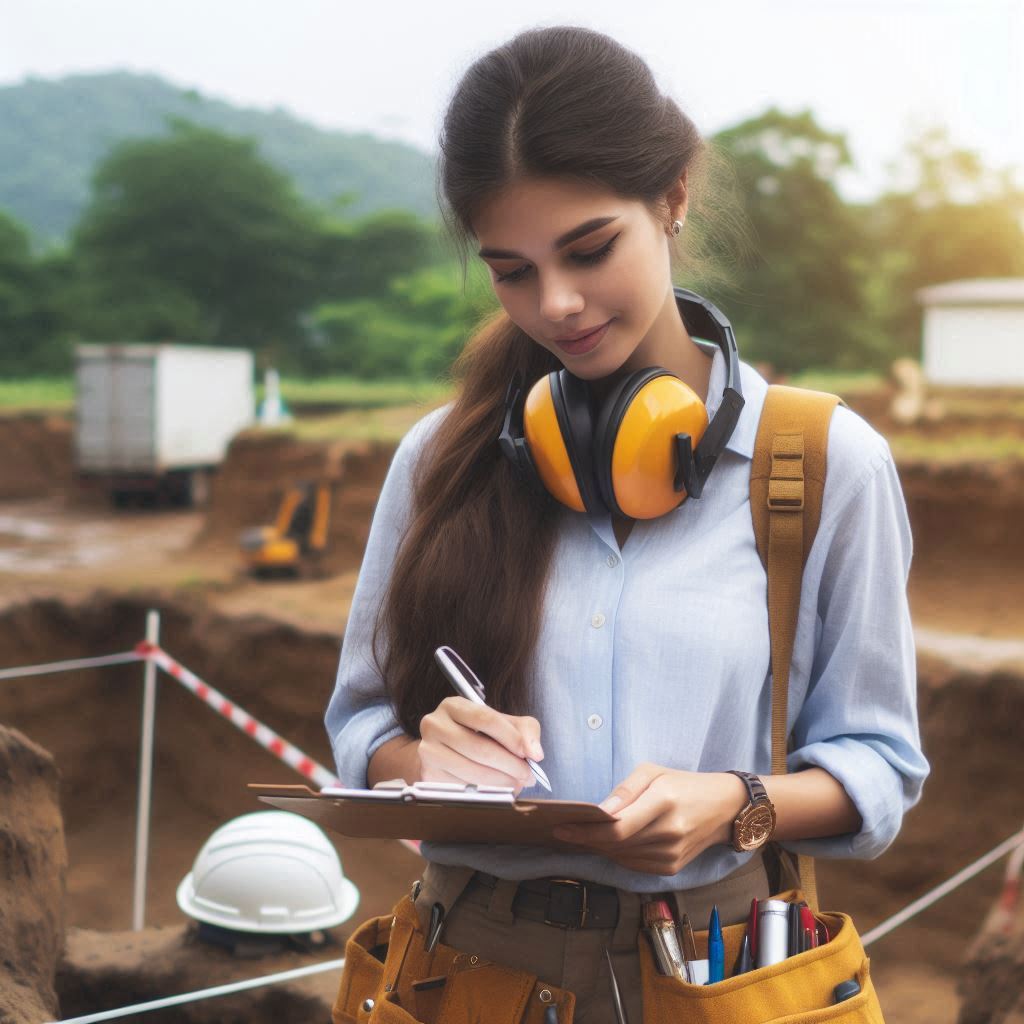Introduction
Climate change refers to long-term alterations in global weather patterns, temperatures, and environmental conditions, primarily driven by human activities such as the burning of fossil fuels, deforestation, and industrial pollution.
Over the past century, these activities have accelerated the release of greenhouse gases, leading to rising global temperatures, melting ice caps, and shifting ecosystems.
The consequences of these changes extend far beyond the natural environment, posing significant threats to various aspects of human civilization, including archaeological sites.
Archaeological sites hold immense historical and cultural value.
These locations, often containing artifacts, structures, and ancient relics, provide a window into past civilizations.
Offering insight into how early societies lived, worked, and interacted with their surroundings.
Preserving these sites is not just about protecting history but also about safeguarding the knowledge and understanding they provide to modern researchers, scholars, and the public.
They help us understand the evolution of cultures, technologies, and societies, giving us lessons to apply in today‘s world.
However, climate change is emerging as a major threat to the preservation of these invaluable sites.
Rising sea levels, more frequent storms, and extreme weather events are accelerating the destruction of many archaeological locations, particularly those near coastlines and in vulnerable environments.
Coastal erosion is washing away centuries-old artifacts, while increased flooding and heavy rainfall are damaging ancient structures.
Even sites that have survived for thousands of years are now at risk of disappearing due to rapid environmental changes.
Overview of climate change and its effects
Explanation of Climate Change and Global Warming
Climate change refers to significant, long-term shifts in temperature and weather patterns.
Global warming, the primary driver of climate change, is caused by human activities such as burning fossil fuels and deforestation.
These activities release large amounts of greenhouse gases into the atmosphere, which trap heat and increase global temperatures.
As the Earth warms, ecosystems are disrupted, and natural disasters become more frequent and intense.
The consequences of global warming are widespread, affecting not only the environment but also human infrastructure and cultural heritage.
Examples of Extreme Weather Events Caused by Climate Change
Extreme weather events are a direct result of climate change.
Heatwaves are becoming more intense and frequent, breaking temperature records worldwide.
These heatwaves dry out vegetation, leading to wildfires that destroy vast tracts of land, including areas with ancient archaeological significance.
Storms, hurricanes, and cyclones have also intensified, causing massive flooding and wind damage.
Heavy rainfall events erode the ground, which can damage or completely wash away archaeological sites.
Droughts, on the other hand, can expose ancient remains that were previously hidden, but they also make preservation efforts more difficult.
How Rising Sea Levels Affect Coastal Archaeological Sites
Rising sea levels are one of the most critical effects of climate change, particularly for coastal archaeological sites.
Global warming causes polar ice caps and glaciers to melt, adding more water to the oceans and raising sea levels.
Coastal erosion accelerates as the land is submerged by seawater.
Archaeological sites located near the coast, some of which are thousands of years old, are at great risk of being submerged or eroded away.
In regions like Scotland, Peru, and the Mediterranean, ancient settlements are now threatened by the encroaching sea, endangering invaluable historical knowledge.
As sea levels continue to rise, the urgency to protect and preserve coastal archaeological sites intensifies.
Vulnerability of Archaeological Sites to Climate Change
Archaeological sites are highly vulnerable to the effects of climate change.
Many sites are located in coastal, desert, or mountainous areas, where extreme weather events are becoming more common.
Rising temperatures, increased precipitation, and natural disasters threaten the structural integrity of these sites.
Ancient structures that have survived for thousands of years are now at risk of rapid deterioration.
Without immediate action, valuable historical records may be lost forever.
Effects of Erosion on Archaeological Structures
Erosion is one of the most damaging effects of climate change on archaeological sites.
Heavy rainfall, rising sea levels, and stronger storms accelerate soil erosion, which can destabilize the land around ancient structures.
Erosion strips away the protective layers of soil that have preserved artifacts for centuries.
As the earth shifts, foundations weaken, and walls collapse, leaving historical sites vulnerable to further damage.
Over time, erosion can obliterate irreplaceable cultural heritage.
Threat of Increased Flooding on Sites
Increased flooding, a direct consequence of climate change, poses a severe threat to many archaeological sites.
Floodwaters can wash away artifacts, damage fragile structures, and disturb carefully preserved layers of history.
Coastal and riverbank sites are particularly at risk as rising sea levels cause more frequent and intense floods.
The aftermath of flooding leaves behind water damage, mold, and weakened structures, making it harder for preservation efforts to succeed.
Impact of Changing Temperature and Precipitation Patterns on Site Preservation
Changing temperature and precipitation patterns significantly impact the preservation of archaeological sites.
In areas experiencing prolonged droughts, ancient artifacts can be exposed to the elements, leading to accelerated decay.
On the other hand, increased rainfall can lead to waterlogging, which weakens the structural foundations of historic buildings.
Fluctuating temperatures cause materials like stone, brick, and wood to expand and contract, which can lead to cracks and degradation.
These shifts make it more challenging to preserve historical sites and artifacts for future generations.
Read: Exploring the Different Branches of Geology
Case Studies of Archaeological Sites Impacted by Climate Change
Climate change is taking a heavy toll on many famous archaeological sites around the world.
Some sites have already suffered damage, while others are at high risk.
Iconic places like Pompeii in Italy and Mesa Verde in the United States provide critical lessons on how vulnerable these historical treasures are to environmental changes.
Understanding how these sites have been affected by climate change can help develop strategies to mitigate further damage.
Pompeii: Climate Change Threats to a Buried City
Pompeii, the ancient Roman city buried by the eruption of Mount Vesuvius in 79 AD, faces significant risks from climate change.
The site, famous for its well-preserved ruins, has been exposed to increased rainfall and fluctuating temperatures in recent years.
Excessive rainwater has caused waterlogging, damaging ancient frescoes and weakening the city‘s walls.
Temperature shifts have led to cracks and structural instability, making it harder to preserve the ruins.
Conservation efforts now focus on improving water drainage systems and applying modern techniques to stabilize vulnerable structures.
Mesa Verde: A Struggle Against Erosion and Fires
Mesa Verde, a UNESCO World Heritage Site in Colorado, is home to ancient cliff dwellings of the Ancestral Puebloans.
This site is particularly vulnerable to erosion and wildfires, both of which have been exacerbated by climate change.
Wildfires, fueled by increasingly dry conditions and rising temperatures, threaten the sandstone cliff structures.
Erosion from heavy rains also weakens the cliffs, endangering these historical dwellings.
Efforts to protect Mesa Verde include fire prevention strategies, erosion control measures, and continuous monitoring of the site‘s geological stability.
Efforts to Mitigate the Effects of Climate Change on These Sites
In both Pompeii and Mesa Verde, significant efforts are being made to mitigate the impact of climate change.
In Pompeii, teams are working to improve drainage systems to prevent further water damage.
They are also using advanced materials to repair cracks and fortify the ancient walls.
For Mesa Verde, climate scientists and archaeologists are collaborating to manage fire risks by clearing nearby vegetation and implementing controlled burns to reduce the chances of catastrophic wildfires.
Erosion control methods, such as retaining walls and vegetation planting, are also being used to protect the site.
These examples show that, while climate change poses serious risks to archaeological sites, proactive measures can reduce its impact.
Continued research, monitoring, and intervention are essential to safeguarding these irreplaceable treasures for future generations.
Read: Top Skills Needed for a Successful Geology Career

Importance of Adaptation and Preservation Strategies
Adapting and preserving archaeological sites is critical in the face of climate change.
These sites represent invaluable cultural heritage and historical knowledge that must be safeguarded.
With the increasing intensity of climate-related impacts, implementing adaptation strategies is essential for their survival.
By taking proactive steps, we can ensure that future generations continue to benefit from the insights and history these sites provide.
The Need for Adaptation Plans for Archaeological Sites
Climate change requires urgent adaptation plans to protect vulnerable archaeological sites.
Rising sea levels, stronger storms, extreme temperatures, and wildfires all pose significant threats.
Without comprehensive plans, many sites will suffer irreversible damage or even total destruction.
Adaptation plans must account for the specific climate risks each site faces, including tailored strategies for coastal erosion, fire prevention, and water damage.
Preservation experts, climate scientists, and local authorities need to collaborate to create effective long-term solutions.
Overview of Preservation Techniques to Protect Sites from Climate Change Effects
A variety of preservation techniques are being developed and used to protect archaeological sites from the effects of climate change.
For coastal sites at risk of rising sea levels, seawalls and breakwaters are built to prevent erosion.
Drainage systems are installed at many locations to reduce waterlogging caused by heavy rainfall.
In areas prone to wildfires, vegetation management and controlled burns help to lower fire risks.
Climate monitoring tools and advanced materials, such as weather-resistant coatings, are also used to fortify vulnerable structures.
Additionally, digital preservation techniques, including 3D scanning and virtual modeling, provide backup records in case physical damage occurs.
Examples of Successful Preservation Efforts at Vulnerable Sites
Several archaeological sites have seen success with adaptation and preservation efforts.
At Scotland‘s Skara Brae, a Neolithic settlement, seawalls have been constructed to combat coastal erosion.
Regular monitoring of the shoreline helps manage risks and prevent future damage.
In Peru, preservation efforts at the famous Machu Picchu site include reforestation and careful management of water flow to prevent landslides and erosion.
Similarly, in the Maldives, efforts to raise certain low-lying areas are being explored to prevent flooding of ancient cultural sites.
These successful examples highlight the importance of acting quickly and creatively to preserve archaeological treasures.
By developing targeted adaptation strategies and applying innovative preservation techniques, we can mitigate the effects of climate change on these irreplaceable historical sites.
Read: The Future of Botany: Emerging Fields and Innovations
Gain More Insights: Understanding Forensic Psychology Basics
Transform Your Career Today
Unlock a personalized career strategy that drives real results. Get tailored advice and a roadmap designed just for you.
Start NowUncover the Details: How to Build a Strong Bioinformatics Portfolio
Involvement of Archaeologists and Climate Scientists in Preservation Efforts
Archaeologists and climate scientists play crucial roles in preserving archaeological sites endangered by climate change.
Archaeologists study these sites to understand their historical significance, while climate scientists analyze environmental changes that threaten them.
Together, they collaborate to assess risks and develop strategies to safeguard these cultural treasures.
This partnership ensures that both historical knowledge and environmental data guide the preservation process.
Collaboration Between Different Fields to Address Climate Change Impacts
Effective preservation efforts require collaboration between various disciplines, including archaeology, climate science, engineering, and conservation.
Engineers design protective structures like seawalls to counteract coastal erosion.
Conservation experts offer insights into materials preservation, while archaeologists provide the historical context of each site.
Climate scientists analyze future risks, enabling teams to create long-term solutions that can withstand the challenges of rising sea levels, extreme weather events, and changing environmental conditions.
This multidisciplinary approach maximizes the chances of successfully preserving vulnerable archaeological sites.
Role of Archaeologists in Advocating for Climate Action
Archaeologists are increasingly advocating for climate action to protect not only archaeological sites but also the environment as a whole.
By highlighting how climate change threatens cultural heritage, archaeologists draw attention to the broader impacts of environmental degradation.
They collaborate with policymakers, urging them to implement climate-friendly policies that prioritize conservation.
Archaeologists also educate the public about the importance of taking immediate action to reduce carbon emissions and prevent further damage to both the environment and cultural heritage.
Importance of Interdisciplinary Research in Understanding and Preserving Archaeological Sites
Interdisciplinary research is vital for understanding the full impact of climate change on archaeological sites.
Archaeologists, geologists, hydrologists, and biologists often work together to study how climate factors affect different aspects of these locations.
For example, archaeologists might collaborate with geologists to analyze soil erosion patterns or with biologists to understand the impact of changing ecosystems on preservation.
This broad, collaborative approach provides a more comprehensive understanding of the risks and helps develop more effective preservation techniques.
In the face of climate change, interdisciplinary research is critical for developing innovative solutions.
By combining expertise from multiple fields, researchers can better anticipate the long-term effects of climate change on archaeological sites and create strategies to protect these historical landmarks for generations to come.
Read: What Does a Geologist Do? Career Overview and Insights
Gain More Insights: Biomedical Engineering and the Future of Telemedicine
Future Challenges and Opportunities in Preserving Archaeological Sites
The preservation of archaeological sites faces significant challenges as climate change continues to intensify.
Rising sea levels, more frequent extreme weather events, and shifting ecosystems will create new threats to vulnerable sites.
However, these challenges also present opportunities for innovation and global collaboration.
By addressing these issues now, we can develop advanced preservation techniques that protect not only historical landmarks but also future archaeological discoveries.
Future Climate Change Impacts on Sites
Climate models predict increasingly severe effects on archaeological sites in the coming decades.
Coastal sites will face greater risks from rising sea levels and coastal erosion, while inland areas may be threatened by desertification, drought, and flooding.
As temperatures rise, more extreme heat could cause cracks and degradation in ancient structures made of stone, brick, and clay.
Additionally, the rapid melting of permafrost may expose long-buried artifacts, leading to a race against time to preserve them before they deteriorate.
These future climate impacts demand swift and proactive solutions.
Potential Solutions and Innovations in Site Preservation
Innovative technologies and strategies are already being explored to preserve archaeological sites against future climate impacts.
For coastal erosion, protective barriers such as seawalls or artificial reefs can reduce wave impact and protect shorelines.
Advances in 3D scanning and digital modeling allow for the creation of precise records of archaeological sites, enabling virtual preservation even if physical damage occurs.
New materials, such as advanced coatings, are being developed to protect structures from temperature fluctuations and water damage.
Additionally, researchers are exploring ways to relocate or elevate particularly endangered sites.
Sustainable energy use and reduced carbon footprints at conservation sites are other forward-looking solutions.
Solar-powered monitoring systems, combined with remote sensors, enable constant surveillance of site conditions while minimizing environmental impact.
Investing in renewable energy sources for conservation efforts will also help reduce the broader impact of climate change, contributing to the preservation of archaeological sites for future generations.
Call to Action for Individuals and Organizations to Support Preservation Efforts
Preserving archaeological sites is a global responsibility, and individuals and organizations can play a vital role.
Supporting local and international preservation projects, whether through donations or volunteer work, helps raise awareness and funds for critical conservation efforts.
Governments and NGOs must collaborate to implement policies that protect cultural heritage from the growing threat of climate change.
Individuals can also help by advocating for climate-friendly policies, reducing personal carbon footprints, and spreading awareness about the importance of preserving our shared history.
As climate change continues to challenge the preservation of archaeological sites, it is crucial for everyone to contribute to solutions.
By supporting innovative preservation techniques, raising awareness, and taking action to fight climate change, we can protect our cultural heritage for future generations.
Conclusion
Climate change has a profound impact on archaeological sites, causing significant damage through rising sea levels, increased erosion, and more frequent extreme weather events.
These environmental changes threaten the preservation of invaluable historical and cultural treasures, many of which are irreplaceable.
As the effects of climate change intensify, the risk of losing these artifacts and the knowledge they hold about our past becomes greater.
It is crucial that we recognize the importance of preserving these sites, not only for their historical value but also for future generations to study and appreciate.
Without active preservation efforts, vital pieces of human history could disappear forever, erasing important links to our cultural heritage.
Continued research, monitoring, and protective actions are essential to mitigate the effects of climate change on these sites.
Governments, researchers, and local communities must collaborate to protect and preserve these archaeological treasures.
By prioritizing the safeguarding of these sites, we ensure that future generations can continue to learn from and appreciate our shared history.




